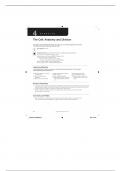4 E X E R C I S E
The Cell: Anatomy and Division
The Anatomy of the Composite Cell section can be given as an out-of-class assignment to save time.
This might be necessary if audiovisual material is used.
Time Allotment: 2 hours.
Multimedia Resources: See Appendix B for Guide to Multimedia Resource Distributors.
Inside the Living Cell (WNS: 50 minutes, DVD)
An Introduction to the Living Cell (CBS: 30 minutes, DVD)
A Journey Through the Cell (FHS: DVD)
Part One: Cells: An Introduction (20 minutes)
Part Two: Cell Functions: A Closer Look (20 minutes)
Mitosis and Meiosis (DE: 23 minutes, VHS, DVD)
Practice Anatomy Lab™ 3.0 (PAL) (PE: DVD, Website)
Laboratory Materials
Ordering information is based on a lab size of 24 students, working in groups of 4. A list of supply
house addresses appears in Appendix A.
3-D model of composite cell or chart 24 slides of human blood cell smear 3-D models of mitotic stages
of cell anatomy 24 slides of sperm Video or animation of mitosis
24 slides of simple squamous 24 slides of whitefish blastulae Chenille sticks (pipe cleaners), two
epithelium 24 compound microscopes, lens paper, different colors, cut into 3-inch
24 slides of teased smooth muscle lens cleaning solution, immersion pieces
oil
Advance Preparation
1. Set out slides (one per student) of simple squamous epithelium, teased smooth muscle, human blood cell smear, sperm, and
whitefish blastulae. Students will also need lens paper, lens cleaning solution, immersion oil, and compound microscopes.
2. Set out a model or a lab chart of a composite cell, and models of mitotic stages.
3. Obtain the chenille sticks (pipe cleaners) in two different colors, and cut each into 3-inch pieces. Set out 8
pieces per group, 4 of each color.
Comments and Pitfalls
1. Observing differences and similarities in cell structure often gives students trouble, as many of them have
never seen any cells other than epithelial cells. Slides or pictures of these cell types might help.
18 Copyright © 2014 Pearson Education, Inc.
MARI1702_11_C04_pp018-023.indd 18 2/20/13 10:10 AM
, Answers to Pre-Lab Quiz (p. 39)
1. The structural and functional unit 6. interphase
of all living things. 7. false
2. a, chromatin 8. Four
3. d, selective permeability 9. b, interphase
4. Ribosomes 10. false
5. c, mitochondria
Answers to Activity Questions
Activity 5: Observing Various Cell Structures (pp. 44–45)
4. Simple squamous epithelial cells are relatively large and irregularly (“fried-egg”) shaped. Smooth muscle
cells are also relatively large, but are long and spindle shaped. Red blood cells and sperm are both exam-
ples of small cells. Red blood cells appear round, while sperm cells are streamlined with long flagella.
Cell shape is often directly related to function. Epithelial cells fit tightly together and cover large areas.
Elongated muscle cells are capable of shortening during contraction. The red blood cells are small enough
to fit through capillaries, and are actually biconcave in shape, which makes them flexible and increases
surface area (not obvious to the students at this point). Sperm cells’ streamlined shape and flagella are
directly related to efficient locomotion.
The sperm cells have visible projections (flagella), which are necessary for sperm motility.
The function of sperm is to travel through the female reproductive system to reach the ovum in the uterine
tubes. This requires motility, provided by the flagella.
None of the cells lacks a plasma membrane.
Mature red blood cells have no nucleus.
Nucleoli will probably be clearly visible in the epithelial cells, and possibly visible in the other nuclei.
No. Identifiable organelles are not visible in most of these cells. Filaments may be visible in the smooth
muscle preparations. The details of organelle structure are usually below the limit of resolution of the light
microscope. Unless special stains are used, there is no way to see or distinguish the organelles at this level.
Activity 7: “Chenille Stick” Mitosis (p. 48)
2. The centromere
3. The mitotic spindle
4. Kinetochores
The nuclear envelope
5. The metaphase plate
6. Pulling apart of the sister chromatids.
Each sister chromatid is now a chromosome.
7. The events of telophase cause the chromosomes and cell structures to revert to their interphase appear-
ance: the chromosomes uncoil, a nuclear envelope forms around each chromatin mass, nucleoli appear in
the nucleus, and the spindle breaks down and disappears.
Copyright © 2014 Pearson Education, Inc. Exercise 4 19
MARI1702_11_C04_pp018-023.indd 19 2/20/13 10:10 AM




